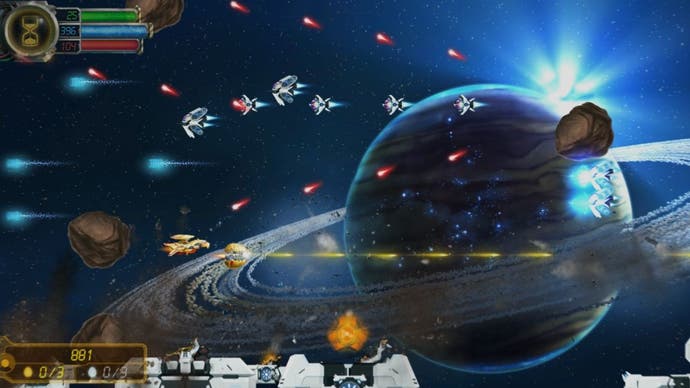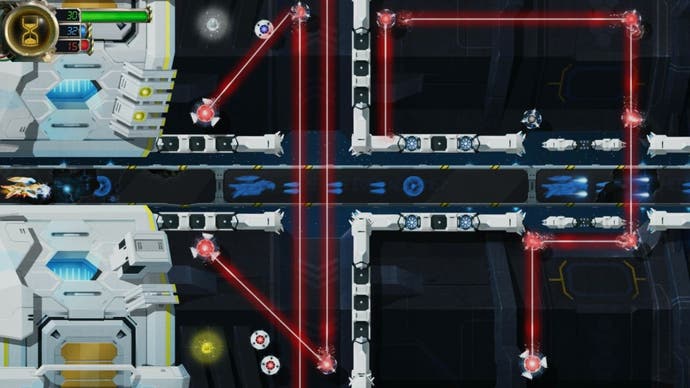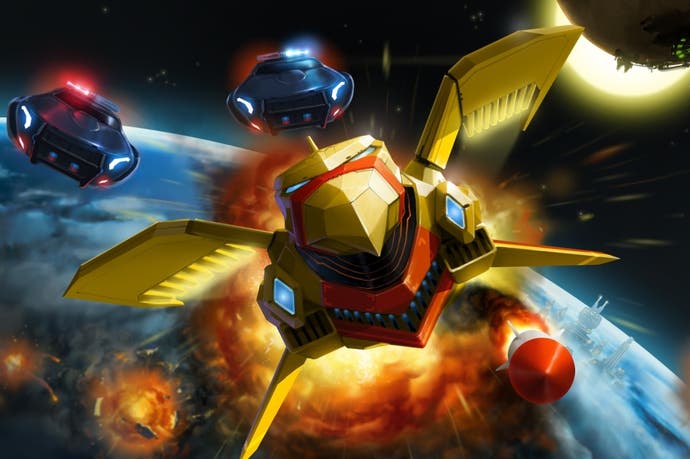Humans Must Answer review
Chicken run.
The scrolling shoot-'em-up, or shmup as it is sometimes lip-smackingly known, is perhaps gaming's most conservative genre. This is a style of gaming that has its roots in the very earliest days of the arcade, found its ideal form not long after and has resisted any attempts to deviate from that formula in the decades since.
There have been innovations, of course, but those mostly come from enterprising specialist developers playing around within the fairly rigid boundaries that fans expect. Ikaruga found brilliance just by making the colour of your bullets and enemies a central part of its design. Sine Mora tethered time limit and score together, forcing the player to keep scoring in order to stay in the game. Humans Must Answer... well, it's hard to pin down one single innovation that this enthusiastic indie brings to the genre.
There are several areas where Humans Must Answer deviates from the expected horizontal shmup script, but they feel scattershot in nature - exploratory doodles waiting to be refined into something more deep and detailed.
The story, for what it's worth, finds a spaceship full of sentient chickens making its way towards a distant future version of Earth in search of something mysterious. Playing as these chickens, you find Earth's forces are out to stop you, but the cheeky inversion of the expected roles doesn't really come across in the gameplay. Your spaceship shoots the other spaceships, and it's only the occasional Star Fox-style dialogue window or cut-scene that reminds you that you're supposedly a feathered alien rather than a stoic human pilot.

R-Type is the most obvious inspiration here, as you enter battle with an energy weapon which automatically recharges when not being fired and a matter weapon, the finite ammo for which must be replenished in the field. Both weapon types can also be deposited as a remote turret, which stays in place for a few seconds, doubling your firepower in a particular spot.
Improving this arsenal relies not on the proven standby of collecting power-ups dropped by defeated enemy waves, but by purchasing permanent upgrades and new weaponry in a between-levels shop, with your cash reserves tied to your score. Meanwhile, the upgrades available - and indeed the levels that are open to you - depend on the number of golden and silver eggs you find in each stage.
It's here that the game starts to get tangled up in a few too many ideas, none of which feels fully developed or integrated into the arcade shmup framework. There's a purity to the old style of power-ups, rewarding perfection with escalated attack power, and punishing carelessness by taking it away again. It all takes place in the moment, in the zen state where muscle memory and whiplash reflexes meet; where the shoot-em-up thrives.
Humans Must Answer severs that connection in favour of a progression system that feels more like a first-person shooter or role-playing game in its pacing. That's perhaps not so surprising, given that the team at Ukrainian developer Sumom Games cut its teeth working on the S.T.A.L.K.E.R series, but it's never an entirely comfortable fit with the genre. Your ship moves sluggishly as well, apparently to make navigating the denser, later stages more manageable, but few players will make it that far as the same slow movement is often fatal in the early levels.
Tying the upgrades to hidden eggs proves a more persistent issue as you get further into the game. These eggs are central - not only in accessing the later levels, but in making sure your arsenal is up to the job once you get there - yet finding them is almost always down to luck rather than skill. They're awarded not for being good at shooting enemies but for blowing up random bits of scenery. There's nothing to indicate which objects hide these vital tokens, no twinkle or glow to catch your eye, so your attention is constantly divided between surviving the waves of enemies and scouring the edges of the screen for anything that looks like it might explode.

This leads into another of Humans Must Answer's awkward foibles - the need to explore. Once you reach the fifth stage and beyond, switches, eggs and other trinkets are increasingly tucked away in dead ends where it's easy to be trapped by the forced scrolling.
The game has an appealing visual style but sometimes lets showmanship get in the way of functionality. Foreground objects can obscure not only your ship but the HUD icons showing your ammo and health. As it's not always clear when you're heading down a path of no escape, and since the game retains the hardcore element of forcing you to replay the entire level when you die, it means that the trial and error needed to not only beat a stage but unlock the next becomes increasingly problematic.
Laid out one by one, these issues seem insurmountable. That they don't overwhelm Humans Must Answer is down to satisfying production values and generally solid shooting that means, even in its most frustrating moments, the game still retains an element of fun. Carving your way through an undulating maze of enemies is still a pleasure, even if the game never pulls it off with the grace and balance you'd expect from the genre's reigning titans.
Humans Must Answer comes from a place of honest passion and enthusiasm for the shmup, but feels torn between recreating the feeling of hammering coins into a cabinet in 1987 and doing things differently just for the sake of being different. The two never find an equilibrium, leaving the game's best ideas underdeveloped and its mistakes awkwardly exposed. It's a game that will appeal most to die-hard retro shmup aficionados but they, ironically, are the ones most likely to have trouble reconciling Humans Must Answer's muddled heart.

